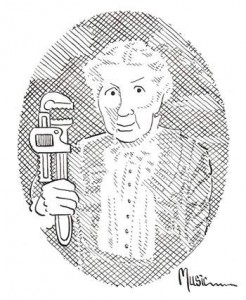Gazette Technical Wizard Pure Water Annie Takes on the Persistent Questions about TDS Measurement in Home Reverse Osmosis Units
How do I know when to change my RO membrane?
Some sellers say every two years, other say every three. Actually, the only really good way to know is to own a TDS tester, test the water from the unit once or twice a year, and change the membrane when the meter tells you it’s time. Membranes can last many, many years, and there is no reason ever to change a membrane that is performing well.
What does TDS mean, and what’s a TDS meter?
TDS stands for “Total Dissolved Solids.” It is basically a measurement of all the “solids,” or minerals, dissolved in the water. The “dissolved solids” consist mainly of calcium and magnesium (hardness minerals) and sodium, chloride, and sulfate. A TDS tester for home use is a small electronic tester that measures these solids by passing a weak electrical current through the water and determining how well the water conducts electricity. The higher the dissolved solids content, the more easily the water conducts electricity and the higher the number shown on the meter.
![rc400[1]](http://www.purewatergazette.net/blog/wp-content/uploads/2012/12/rc4001-169x300.jpg)
Does my RO unit remove the TDS from the water?
Yes, a healthy RO membrane will normally “reject” 90% or more of the dissolved solids and send them down the drain pipe. RO units and distillers lower dissolved solids. as do “deionizers.” Filters don’t removed dissolved minerals. No matter how many sediment filters or carbon filters you run the water through, the TDS reading will remain the same.
Is TDS bad? How high should it be?
Within the normal range of fresh water, TDS isn’t a big health issue. The EPA sets a limit of 500 parts per million Total Dissolved Solids as a drinking water standard, but many US cities violate that and their citizens do fine. Obviously, there is a point where water starts tasting bad. This varies depending on which minerals are involved. Naturally soft water with a TDS of 500 that’s mainly sodium, for example, can taste very good. There is, of course, a limit: sea water is over 30,000 parts per million and is undrinkable. When water gets over 1000 ppm TDS you normally won’t like the way it tastes.
My local tap water is 250 ppm Total Dissolved Solids. If you’re saying this isn’t “bad for me,” why bother to measure my RO unit’s dissolved solids performance? What does it matter whether the RO unit reduces the TDS or not?
TDS measurement is the standard way of evaluating overall performance of the RO unit. The assumption is that if the unit is making a 90% reduction of calcium and sodium, it’s also reducing arsenic and fluoride with equal effectiveness. As it loses its ability to reduce TDS, it loses its ability to remove chromium. In other words, TDS readings are taken to determine how well the membrane is working.
What does “% rejection” mean?
Percent rejection is a calculation used to express how well the RO unit is working. It is determined as follows:
TDS of the feed water (determined by testing your tap water at the kitchen sink) minus the TDS of the permeate (the water that comes out of the RO unit’s faucet) divided by the TDS of the feed water and multiplied by 100.
So, for example, if your tap water reads 280 and your RO product water reads 15, you determine the percent rejection of the RO unit by subtracting 15 from 280 to get 265, dividing 265 by 280 to get 0.946, then multiplying by 100 to get 94.6% rejection. Your RO unit is running well.
You actually don’t have to work through this whole formula to know if you’re RO unit is running well. If the RO water tests 1/10 or less of the tap water, it’s doing fine. If your tap TDS is 280 and the RO water reads 28 or less, leave the membrane alone.
At what TDS reading should you change the membrane?
That’s a personal choice and there isn’t a specific answer that fits all situations. Consider, for example, that if your tap water TDS is only 65 you might want to cut your membrane some slack and not stick strictly to the 10% rule.
Are there factors that affect TDS readings that should be considered?
First, never test your TDS immediately after changing your filters. You’ll get an artificially high reading because of impurities that your eye can’t see being put out by the new post filter. Also, keep in mind that cold water reads lower than warm and a stopped up pre-filter can rob the membrane of pressure and diminish its performance. Lots of things can affect TDS readings, so don’t pull the plug on your membrane if you get one bad test reading.





